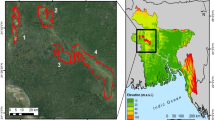Abstract
Remote sensing devices are keeping eyes on the earth surface to acquire information directly and quickly. A remote sensing image carries information about the biophysical materials of the million acres of land and hence identification and extraction of earth features from the remote sensing big data is the major application of remote sensing. In the present work Landsat-8 and Sentinel-2 data are used to extract water bodies in Prayagraj district, Uttar Pradesh, India. There are two problems observed in dealing with panchromatic band of Landsat-8 in the study area i.e., meet but don’t mix and feature mixing. The meet but don’t mix problem refers to the classification of water regions of two confluencing rivers into two different classes. On the other hand, feature mixing refers to the mixing of water regions with neighboring vegetation regions during classification. It is claimed in past research that the Near InfraRed (NIR) band is suitable for water enhancement as the other Land Use Land Cover (LULC) features are suppressed. So, the Panchromatic (PAN) band is fused with Infra-Red band using Principal Component Analysis (PCA). The fused images are classified and it is observed that the aforesaid two problems are resolved and the overall classification accuracy is improved from 74.23% to 89.1% after fusion.







Similar content being viewed by others

Data availability
The authors show their gratitude to the https://earthexplorer.usgs.gov/ for providing satellite imageries freely for the research work.
References
Aanæs H, Sveinsson JR, Nielsen AA, Bovith T, Benediktsson JA (2008) Model-based satellite image fusion. IEEE Trans Geosci Remote Sens 46(5):1336–1346
Ablin, R, Sulochana CH, Prabin G. (2019) An investigation in satellite images based on image enhancement techniques. Eur J Remote Sens, pp. 1-9
Al-Wassai, FA, Kalyankar NV, Al-Zaky AA. (2011) Studying satellite image quality based on the fusion techniques. arXiv preprint arXiv:1110.4970
Batur E, Maktav D (2018) Assessment of surface water quality by using satellite images fusion based on PCA method in the Lake gala, Turkey. IEEE Trans Geosci Remote Sens 57(5):2983–2989
Chi M, Plaza A, Benediktsson JA, Sun Z, Shen J, Zhu Y (2016) Big data for remote sensing: challenges and opportunities. Proc IEEE 104(11):2207–2219
Choi J, Yu K, Kim Y (2010) A new adaptive component-substitution-based satellite image fusion by using partial replacement. IEEE Trans Geosci Remote Sens 49(1):295–309
Feyisa GL, Meilby H, Fensholt R, Proud SR (2014) Automated water extraction index: a new technique for surface water mapping using Landsat imagery. Remote Sens Environ 140:23–35. https://doi.org/10.1016/j.rse.2013.08.029
Fisher A, Flood N, Danaher T (2016) Comparing Landsat water index methods for automated water classification in eastern Australia. Remote Sens Environ 175:167–182. https://doi.org/10.1016/j.rse.2015.12.055
Gharbia, R, Azar AT, Baz AE, Hassanien AE. (2014) Image fusion techniques in remote sensing. arXiv preprint arXiv:1403.5473
Lacaux JP, Tourre YM, Vignolles C, Ndione JA, Lafaye M (2007) Classification of ponds from high-spatial resolution remote sensing: application to Rift Valley fever epidemics in Senegal. Remote Sens Environ 106:66–74. https://doi.org/10.1016/j.rse.2006.07.012
Liu, P (2015) A survey of remote-sensing big data frontiers in Environmental Science, 3(45). https://doi.org/10.3389/fenvs.2015.00045
McFeeters SK (1996) The use of the normalized difference water index (NDWI) in the delineation of open water features. Int J Remote Sens 17(7):1425–1432
Metwalli MR, Nasr AH, Allah OSF, El-Rabaie S, Abd El-Samie FE (2010) Satellite image fusion based on principal component analysis and high-pass filtering. JOSA A 27(6):1385–1394
Mondejar JP, Tongco AF (2019) Near infrared band of Landsat 8 as water index: a case study around Cordova and Lapu-Lapu City, Cebu, Philippines. Sustain Environ Res 29(1):16
N2YO.com, objects currently in orbit (2018) https://www.n2yo.com/satellites/?c=&t=country. Accessed 15 Jul 2018
Sarp G, Ozcelik M (2017) Water body extraction and change detection using time series: a case study of Lake Burdur, Turkey. J Taibah Univ Sci 11(3):381–391
Shen, L, Li C (2010) Water body extraction from Landsat ETM imagery using Adaboost algorithm. In: Proceedings of the 18th international conference on Geoinformatics, Beijing, pp 1–4. https://doi.org/10.1109/GEOINFORMATICS.2010.5567762
Song H, Huang B (2012) Spatiotemporal satellite image fusion through one-pair image learning. IEEE Trans Geosci Remote Sens 51(4):1883–1896
Wenbo W, Jing Y, Tingjun K (2008) Study of remote sensing image fusion and its application in image classification. Remote Sensing and Spatial Information Sciences 37(B7):1141–1146
Xu H (2006) Modification of normalised difference water index (NDWI) to enhance open water features in remotely sensed imagery. Int J Remote Sens 27:3025–3033. https://doi.org/10.1080/01431160600589179
Yagmur, N, Musaoglu N, Taskin G. (2019) Detection of shallow water area with machine learning algorithms. Int Arch Photogramm Remote Sens Spat Inf Sci 42:1269–1273. https://doi.org/10.5194/isprs-archives-XLII-2-W13-1269-2019.
Yang W, Wang J, Guo J (2013) A novel algorithm for satellite images fusion based on compressed sensing and PCA. Math Probl Eng. https://doi.org/10.1155/2013/708985
Acknowledgements
The first author is thankful to “Ministry of Education” for providing partial financial support to this research work.
Author information
Authors and Affiliations
Corresponding author
Ethics declarations
Conflict of interest
No potential conflict of interest was reported by the authors.
Additional information
Publisher’s note
Springer Nature remains neutral with regard to jurisdictional claims in published maps and institutional affiliations.
Rights and permissions
Springer Nature or its licensor (e.g. a society or other partner) holds exclusive rights to this article under a publishing agreement with the author(s) or other rightsholder(s); author self-archiving of the accepted manuscript version of this article is solely governed by the terms of such publishing agreement and applicable law.
About this article
Cite this article
Mishra, V.K., Chaudhary, P.K. & Pant, T. Image fusion based approach of water extraction from spectrally mixed water regions belonging to the sources of varying nature. Multimed Tools Appl 82, 39783–39795 (2023). https://doi.org/10.1007/s11042-023-15095-5
Received:
Revised:
Accepted:
Published:
Issue Date:
DOI: https://doi.org/10.1007/s11042-023-15095-5



